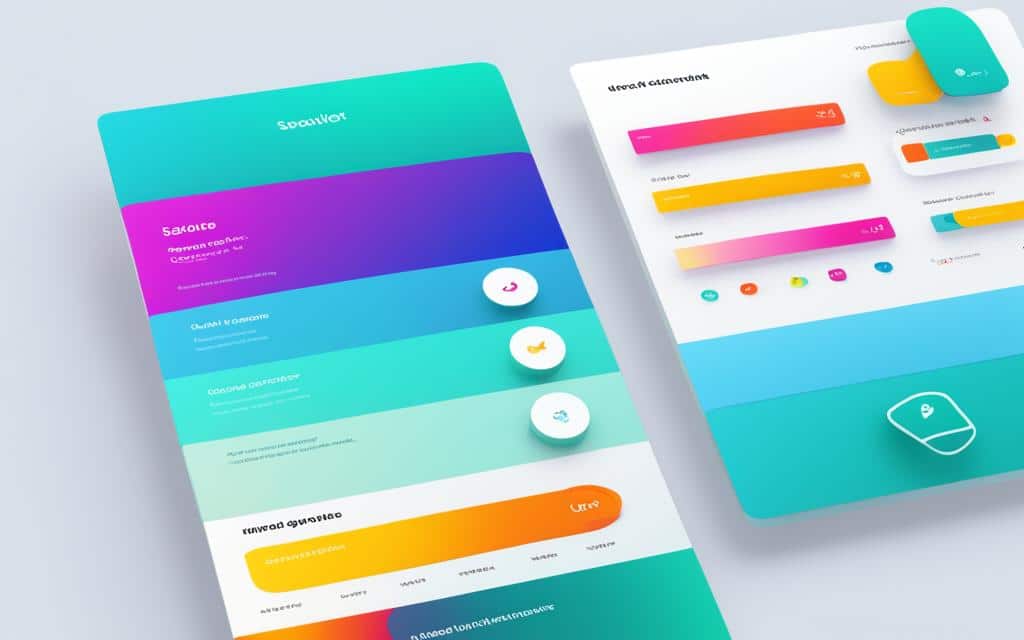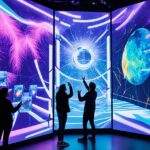Table of Contents
In today’s digital world, the intersection of interactive design and user experience (UX) plays a crucial role in creating seamless and engaging digital interfaces. The term UI (user interface) refers to the visual elements and layout of a digital interface, while UX encompasses the overall user journey and satisfaction.
While the history of UI and UX can be traced back to ancient tools and artifacts designed with the user in mind, it was the development of graphical user interfaces (GUIs) in the 1960s and the introduction of the Macintosh and Windows in the 1980s and 1990s that brought these concepts to the forefront. The launch of the iPhone in 2007 marked a shift in UI design, placing an emphasis on touch-friendly interfaces and intuitive interactions. Meanwhile, the growth of UX research and methodologies ensured that designs were not only aesthetically pleasing but also user-friendly and effective.
Today, UI designers focus on creating visually appealing and intuitive interfaces, employing color schemes, typography, and layout principles to captivate users. On the other hand, UX designers go beyond the visual elements, considering factors such as user behavior, information architecture, and usability to create an overall satisfying and delightful user experience.
In this article, we will explore the difference between UI and UX, delve into key terms and concepts in UI/UX design, examine the role of AI in shaping the future of UI/UX, and discuss the relationship between service design and UI/UX. By understanding these aspects, we can gain valuable insights into how to create exceptional user experiences that drive customer satisfaction and loyalty.
The Difference Between UI and UX
UI and UX are often used interchangeably, but they have distinct roles. UI, short for user interface, focuses on the tangible elements of an interface, such as layout and visual design. On the other hand, UX, or user experience, delves into the overall user experience and satisfaction. While both UI and UX are crucial for a successful product, they play different roles in the design process.
UI is responsible for creating an aesthetically pleasing and intuitive interface. It involves designing the visual elements, selecting the color scheme, typography, and creating a layout that enhances usability. UI designers consider how the interface looks and feels, ensuring that it aligns with the brand, appeals to the target audience, and is visually engaging.
On the other hand, UX focuses on the entire user journey and aims to provide a seamless and enjoyable experience. UX designers conduct user research to understand user needs, behaviors, and motivations. They analyze user feedback and data to improve the product’s usability and overall user satisfaction. UX designers work on mapping user journeys, creating wireframes and prototypes, conducting usability testing, and iterating the design based on user feedback.
“Good UI pushes pixels around. Good UX pushes emotions around.” – Jared Spool
While UI and UX are distinct, they are interconnected and dependent on each other for success. A visually appealing UI can enhance the overall user experience and draw users in. However, a sleek UI alone is not enough to create a delightful user experience. User-centered design principles, such as usability and accessibility, form the foundation of UX, ensuring that users can easily navigate and interact with the interface.
An effective design process involves collaboration between UI and UX designers. UI designers understand the brand’s visual identity and translate it into an interface that aligns with the target audience’s expectations. UX designers conduct user research and testing to ensure the interface meets user needs and provides a positive experience. By working together, UI and UX designers create products that not only look good but also deliver on user expectations.
UI vs. UX: Key Differences
| UI (User Interface) | UX (User Experience) |
|---|---|
| Focuses on visual elements and aesthetics | Focuses on overall user experience and satisfaction |
| Deals with layout, typography, colors, and other visual design elements | Involves user research, prototyping, usability testing, and user feedback analysis |
| Creates an intuitive and visually appealing interface | Ensures a seamless and enjoyable user journey |
UI and UX: Collaborative Endeavors
The collaboration between UI and UX designers is essential for creating exceptional digital experiences. By leveraging their expertise, they can build interfaces that are not only visually appealing but also intuitive, usable, and emotionally engaging. UI brings the interface to life with aesthetically pleasing visuals, while UX ensures that the interface delivers a seamless and enjoyable journey for the user.
Key Terms in UI and UX
To truly understand the concepts and methodologies of UI and UX, it is essential to familiarize yourself with key terms that form the foundation of these disciplines. From usability and accessibility to wireframes and prototypes, these terms encompass the core principles and practices of UI and UX design.
Here are some important key terms in UI and UX:
- Usability: The effectiveness, efficiency, and satisfaction with which users can achieve their goals within a digital interface.
- Accessibility: The design and development practices that ensure digital products are usable and inclusive for people with disabilities.
- Affordance: The visual or physical properties of an object or interface that suggest its function or how it should be used.
- Prototype: A working model or representation of a digital product used for testing, validation, and iteration.
- Wireframe: A low-fidelity visual representation of a digital interface that outlines the structure and content of a page or screen.
- Fidelity: The level of detail and accuracy in a design or prototype, ranging from low-fidelity sketches to high-fidelity pixel-perfect mockups.
- Human-Centered Design: An approach to design that focuses on understanding and addressing the needs, goals, and behaviors of the end users.
- Information Architecture: The way information is organized, structured, and presented within a digital interface to facilitate navigation and understanding.
- Interaction Design: The design of digital interfaces that focuses on how users interact with and engage with the interface elements and functionalities.
- Heuristic Evaluation: A usability evaluation method where experts inspect a digital interface based on predefined heuristics or design principles.
- Micro-Interactions: Small, subtle, and contextual interactions within a digital interface that provide feedback, guidance, or delight to the user.
- User Journey Map: A visual representation of the end-to-end user experience, highlighting key touchpoints, emotions, and pain points.
- User Persona: A fictional character that represents a specific user segment, showcasing their goals, motivations, and behaviors.
- Responsive Design: Designing digital interfaces that adapt and respond to different screen sizes and devices.
- UI Design: The process of creating the visual elements, layout, and interactions of a digital interface to enhance user experience.
- UX Design: The overall process of creating intuitive, useful, and delightful interactions and experiences for users.
Example of a Wireframe:
The Role of AI in UI/UX Design
The field of UI/UX design has been greatly enhanced by the introduction of artificial intelligence (AI). With its ability to analyze user behavior, provide automated design suggestions, and leverage advanced technologies, AI has revolutionized the design process and created personalized experiences. In this section, we will explore the various ways in which AI is transforming UI/UX design and shaping the future of user interaction.
Automated Design Suggestions
AI algorithms can analyze vast amounts of data and generate design suggestions based on user preferences and industry best practices. By analyzing user interactions and patterns, AI can provide designers with insights and recommendations to enhance the UI/UX design process. This not only saves time but also helps create more intuitive and user-friendly interfaces.
Personalized Experiences
Through advanced user behavior analysis, AI algorithms can create personalized experiences for users. By examining user preferences, browsing history, and past interactions, AI can tailor the interface to meet individual users’ needs and preferences. This level of personalization ensures a higher level of user satisfaction and engagement.
Voice Assistants and Chatbots
Voice assistants and chatbots have become increasingly popular in UI/UX design. Powered by AI-driven natural language processing algorithms, these virtual assistants provide seamless user interactions through voice commands or text-based conversations. They enhance user experience by delivering quick and accurate responses, reducing the need for manual input, and providing real-time support.
Visual Recognition Technologies
Visual recognition technologies, such as image and object recognition, have transformed the way users interact with interfaces. AI-powered visual recognition algorithms can identify and understand visual content, making it easier for users to search for products, navigate interfaces, and find relevant information. This enhances the overall user experience by providing efficient and intuitive interactions.
User Testing and Analysis
Traditionally, user testing and analysis involved manual processes that were time-consuming and resource-intensive. However, with AI, these tasks can be automated, allowing designers to collect and analyze user data more efficiently. AI algorithms can track user behavior, gather feedback, and generate actionable insights to optimize the UI/UX design. This helps designers identify pain points, improve usability, and enhance overall user satisfaction.
AI-powered design trends of the future include the integration of virtual reality and augmented reality, realistic animations, and the adoption of voice commands and gesture controls. These advancements will further elevate the user experience and push the boundaries of UI/UX design.
With AI’s transformative capabilities, UI/UX designers have the opportunity to deliver exceptional and personalized experiences that cater to the evolving needs of users. By leveraging AI technologies, designers can create interfaces that are not only visually appealing but also intuitive, engaging, and tailored to individual users’ preferences.
| AI in UI/UX Design | Benefits |
|---|---|
| Automated Design Suggestions | Saves time and improves design quality |
| Personalized Experiences | Enhances user satisfaction and engagement |
| Voice Assistants and Chatbots | Provides seamless user interactions and support |
| Visual Recognition Technologies | Makes interfaces more intuitive and efficient |
| User Testing and Analysis | Optimizes UI/UX design and improves usability |
The Relationship Between Service Design and UI/UX Design
Service design and UX/UI design are two intertwined disciplines that contribute to the creation of user-centric and seamless experiences. While service design focuses on delivering holistic experiences across all touchpoints, UX/UI design specifically deals with the design of interfaces that users interact with.
A user-centric approach is at the core of both service design and UX/UI design. By understanding the needs, motivations, and pain points of users, designers can create solutions that cater to their specific requirements. This user-centricity ensures that the end product or service aligns perfectly with the desires and expectations of the target audience.
Co-creation is another key aspect that connects service design and UX/UI design. In both disciplines, involving users, stakeholders, and other relevant parties in the design process can lead to more effective and innovative solutions. Co-creation allows for greater collaboration, diverse perspectives, and a deeper understanding of user needs, resulting in designs that truly meet their expectations.
Implementing Service Design Principles in UI/UX Design
To implement service design principles into UI/UX design strategies, designers can adopt a holistic approach that considers the entire customer journey. This involves mapping out all the touchpoints and interactions that a user has with a product or service, and ensuring a seamless and integrated experience across these touchpoints.
Service design principles can also be incorporated into the design of individual interfaces. By considering the wider context and the user’s journey, designers can create interfaces that not only look visually appealing but also provide the necessary functionality and usability to deliver a satisfactory experience.
Creating seamless experiences requires a deep understanding of user needs and expectations. User research, usability testing, and feedback analysis are essential tools in the UX/UI designer’s toolkit to gain insights into user behavior and preferences. By continuously iterating and optimizing the design based on user feedback, designers can ensure that the final product or service delivers a seamless and delightful experience.
Conclusion
The integration of AI-powered technology in UI/UX design has transformed the way designers create impactful experiences for users. By harnessing the capabilities of AI, designers can leverage data-driven insights to deliver valuable and meaningful experiences that enhance customer satisfaction and foster brand loyalty.
In order to stay ahead in this rapidly evolving landscape, designers must adapt to technological innovations and embrace the potential of AI. This involves incorporating AI-powered tools and algorithms into the design process, allowing for more efficient workflows and the exploration of new design possibilities.
However, the role of designers remains crucial in AI-powered UI/UX design. While AI can automate certain tasks, it is the designer’s expertise and creativity that enable them to understand user needs and translate them into intuitive and visually appealing interfaces. Designers must continue to champion a user-centric approach, ensuring that technology serves as an enabler rather than a barrier to delivering exceptional user experiences.
Furthermore, by incorporating service design principles into UI/UX strategies, designers can create a more holistic and seamless user journey. This involves understanding the end-to-end user experience and considering all touchpoints where users interact with a product or service. By co-creating with stakeholders and adopting a holistic approach, designers can ensure that every interaction is aligned with the overall brand experience, resulting in enhanced customer satisfaction and loyalty.
FAQ
What is the difference between UI and UX?
UI focuses on the tangible elements of an interface, such as layout and visual design, while UX delves into the overall user experience and satisfaction.
What are some key terms in UI and UX?
Some key terms include usability, accessibility, affordance, prototype, and wireframe.
How does AI impact UI/UX design?
AI revolutionizes UI/UX design by providing automated design suggestions, analyzing user behavior for personalized experiences, enabling voice assistants and chatbots to process natural language, leveraging visual recognition, and automating user tests and analyses.
What is the relationship between service design and UI/UX design?
Service design focuses on creating holistic and seamless user experiences across all touchpoints, while UI/UX design specifically deals with designing the interfaces users interact with.
How can designers deliver exceptional user experiences?
Designers can deliver exceptional user experiences by combining AI with UI/UX design, adapting to technological innovations, adopting a user-centric approach, and incorporating service design principles into UI/UX design strategies.













